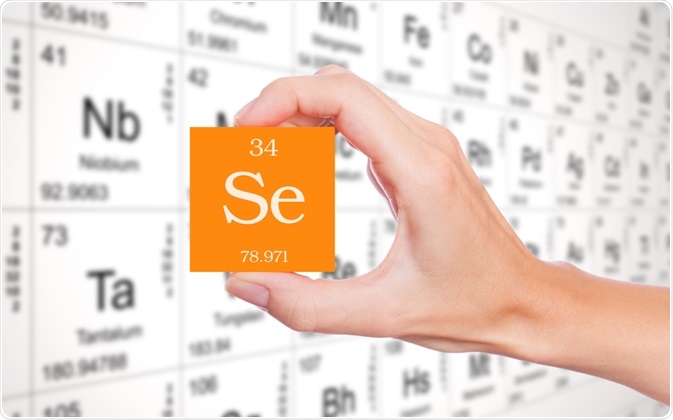The role of selenium in health was first recognized as a toxic one by the recognition of its adverse effects. Being a trace element, only a minute amount is needed to maintain its important physiological roles.

Image Credit: concept w / Shutterstock.com
The recommended dietary allowance is 55 micrograms (µg) per day, based on a reference dose of 0.005 mg/kg body weight/day. The following table shows the upper levels fixed by the United States Food and Drug Administration (FDA). It is important to note that infants should not receive selenium supplementation.
Table 1: Upper Intake Levels for Selenium
| Age |
Male
|
Female
|
|
Infancy
|
45-60 µg
|
45-60 µg
|
|
1-3 years
|
90 µg
|
90 µg
|
|
4-8 years
|
150 µg
|
150 µg
|
|
9-13 years
|
280 µg
|
280 µg
|
|
14-18 years
|
400 µg
|
400 µg
|
|
Adults
|
400 µg
|
400 µg
|
|
Pregnancy and lactation
|
400 µg
|
400 µg
|
As of now, selenium toxicity is diagnosed based upon the presence of features of selenosis in humans, as there are no accurate biochemical or preclinical parameters.
History of selenium toxicity
Selenium toxicity in animals was detected by the occurrence of neurological and muscular symptoms in cattle during the 1930s. This was variously called alkali disease, or blind staggers, and is today thought to represent different stages of the same condition.
The clinical features of blind staggers include vision loss or impairment, random walking, poor feeding, and paralysis. In alkali disease, there is loss of hair, deformed and sloughing hooves, joint erosion, anemia, as well as cardiovascular, hepatic, and renal effects.
In animals, selenium toxicity has also been associated with abnormal fetal development in cattle, swine, and sheep, but with infertility and a higher proportion of runt offspring and fetal deaths.
Chronic selenium toxicity
The symptoms of selenium toxicity depend on the route of exposure.
Inhalation of selenium
The inhalation of selenium compounds causes respiratory membrane irritation, pulmonary edema, bronchial inflammation, and pneumonia. Elemental selenium dust exposure also produces mucous membrane irritation, bleeding from the nose, and coughing, among other symptoms.
Other features include vomiting and nausea, cardiovascular effects, headaches and malaise, and ophthalmic irritation.
Ingestion of selenium
The long-term intake of excessive selenium may involve either organic or inorganic forms in food and/or water. The symptoms of chronic selenium toxicity or selenosis first appear as a garlicky odor in the breath and a metallic taste in the mouth. This is followed by gastrointestinal symptoms such as nausea or diarrhea, tiredness, irritability, and joint pain, all of which occur in approximately 70-75% of patients.
Other characteristic features include loss of mentation, paresthesia, hyperreflexia, nail changes resulting in brittleness, deformation, and loss of nails, alopecia, discoloration and loss of teeth, as well as skin rashes. These are seen in more than 60-65% of patients.
Acute selenium toxicity
Acute toxicity presents with acute respiratory distress syndrome, myocardial infarction, renal failure, vascular symptoms such as tachycardia and flushing of the face, as well as neurological features including tremors, irritability, and myalgia. Echocardiogram (ECG) abnormalities such as T-wave inversion and QT prolongation are often seen, with death often occurring as a result of refractory hypotension
Causes of selenosis
Causes of selenosis range from ingestion of excessive selenium, as is the case of regular snacking on Brazil nuts which could contain up to 90 µg of selenium per nut. There are also many other plants that have the capability to concentrate selenium that is taken up from the soil, which are termed selenium accumulators.
In contrast to the normal plant’s selenium content of 10 parts per million (ppm), even when they grow on selenium-rich soil, selenium accumulators may have concentrations in thousands of ppm. For example, Astragalus racemosus was reported to have a concentration of almost 15,000 ppm of selenium.
These plants are able to grow only on seleniferous soils and are therefore called primary selenium indicators. While found largely in North America, some species do grow in Australia. Other selenium accumulators also exist, which can grow on selenium-poor soils and are referred to as secondary soil accumulators.
Toxic selenium compounds
The most toxic compound of selenium following inhalation is hydrogen selenide. Other toxic compounds include selenium dioxide, sodium selenite, and selenium sulfide. Sodium selenite is the most toxic compound when ingested orally.
Selenium sulfide has been linked with the occurrence of liver and lung tumors in mice and rats following oral exposure. As a result, selenium sulfide is a Group B2 carcinogen as per the Untied States Environmental Protection Agency (EPA) classification. Elemental selenium has low toxicity following oral administration.
The EPA has also classified elemental selenium as a Group D carcinogen, which indicates that it is not classifiable as a human carcinogen.
Causes of selenium toxicity
Exposure to selenium primarily occurs through food, and in some areas with seleniferous soils, through drinking water. Airborne exposure is rare; however, occupational exposure is possible with the chemical processes for recovery of selenium, painting trades, and the metal industries.

Image Credit: Danijela Maksimovic / Shutterstock.com
Gun-bluing chemicals contain a high concentration of selenium and are often involved in acute poisoning. Potential sources of toxic levels of selenium include Astragalus and copper ingestion.
Toxic levels of selenium
Some agencies have put forward a chronic reference exposure level of 0.02 mg/m3 for selenium and its compounds, as well as 0.00008 mg/m3 for hydrogen selenide. These values have been determined based on findings in humans with selenosis and guinea pigs with selenium inhalation toxicity.
Interactions between selenium and other medications
Selenium may exacerbate the effects of:
- Anticoagulants
- Sedatives
- Herbs that impair coagulation such as angelica, cloves, and ginger.
Selenium may impair the effects of:
- Immunosuppressants
- Oral contraceptives
- Cholesterol-lowering agents
- Niacin
- Copper supplements
Supplements that lower the efficacy of selenium:
- Gold salts
- Omega-3 fatty acids
- Zinc
References
Further Reading
Last Updated: Mar 14, 2023